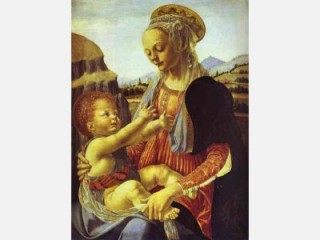
Andrea Del Verrocchio biography
Date of birth : -
Date of death : -
Birthplace : Florence, Italy
Nationality : Italian
Category : Arts and Entertainment
Last modified : 2010-11-29
Credited as : Artist painter, and sculptor of the Renaissance,
The Italian sculptor and painter Andrea del Verrocchio (1435-1488) created some of the most powerful monumental bronze sculptures of the Renaissance.
Andrea del Verrocchio was born in Florence, the son of a brick and tile maker. Nothing is known about his early training. In 1465 the magistrates of the merchants' guild of Florence commissioned him to execute a bronze Doubting of Thomas to occupy a marble niche earlier executed by Donatello and Michelozzo for the principal facade of Orsanmichele in Florence. When the group was finally placed in its niche in 1483, the diarist L. Landucci called the head of Christ "the most beautiful head of the Saviour that has yet been made." The Doubting of Thomas is one of the most important sculpture groups of the entire Renaissance. It is a dramatic masterpiece of spatial arrangement between two high-relief, life-size figures (the statues are actually hollow shells of bronze, without backs) and an exquisitely ornamented Renaissance niche.
The Medici family commissioned a number of works from Verrocchio. In 1467 Cosimo de' Medici was buried in a tomb that had been commissioned from Verrocchio two years earlier. In 1471 he completed the tomb for Giovanni and Piero de' Medici in the old sacristy of the family church of S. Lorenzo in Florence. The rich marble, porphyry, and bronze sarcophagus is framed by a marble arch and backed by a bronze grille in the form of interlaced ropes; it is one of the most original creations of the period. An early masterpiece in bronze, David, a pensive, boyish figure in leather jerkin and skirt, triumphant over Goliath, was commissioned by Lorenzo de' Medici for his villa at Careggi. He sold the David to the Signory of Florence in 1476. Other Medici commissions completed by Verrocchio are listed in an inventory of 1496, including a bust of Giuliano in terra-cotta.
Verrocchio's most notable painting is the Baptism of Christ. During the execution of the painting, about 1470, Verrocchio allowed his young pupil Leonardo da Vinci to paint the head of the first of two angels who kneel at the left and also the spectacular landscape vista above the angel's head. Four other extant paintings are attributed to Verrocchio.
In 1473 Verrocchio estimated the value of a pulpit by Mino da Fiesole and Antonio Rossellino in the Prato Cathedral. In 1477 Verrocchio competed with Piero Pollaiuolo for the monument of Cardinal Niccolò Forteguerri in Pistoia. Although Pollaiuolo's design was accepted, Lorenzo de' Medici ordered the one by Verrocchio executed. In the same year he presented two models for reliefs for the altar of S. Giovanni in the Baptistery of Florence; one, the Beheading of John the Baptist, was accepted and finished in 1480.
Among Verrocchio's marble works is the Bust of a Young Woman, often identified, without proof, as the mistress of Lorenzo de' Medici, Lucrezia Donati. She is clad in a translucent garment and has broad eyebrows and large, beautifully graceful hands. His conception represents the new spirit of naturalism which arose in the 1480s in Florentine sculpture and painting.
Verrocchio's final work is also his grandest: the bronze equestrian monument of Bartolommeo Colleoni in Campo SS. Giovanni e Paolo, Venice. Colleoni, a condottiere, died in 1475 and left money to the Venetian Republic for the execution of the statue. The commission was awarded in 1479, and the model was executed in Florence; it was sent to Venice two years later. Verrocchio moved to Venice in 1483 and died there five years later before he could cast his clay model in bronze. The casting was begun in 1490 by Alessandro Leopardi, who also designed the base on which the monument was finally set in 1496. Verrocchio abandoned Donatello's static concept of the equestrian monument and presented Colleoni, armed and helmeted, riding his charger into battle. Rarely has a sculptor so effectively depicted the expression of power in a dramatic moment.
The best monograph on Verrocchio in English, with a clear text and splendid photographic details of all the works, is Gunther Passavant, Verrocchio: Sculptures, Paintings and Drawings (1969). A succinct and lucid introduction to the master's sculpture is Charles Seymour, Jr., The Sculpture of Verrocchio (1972).
















